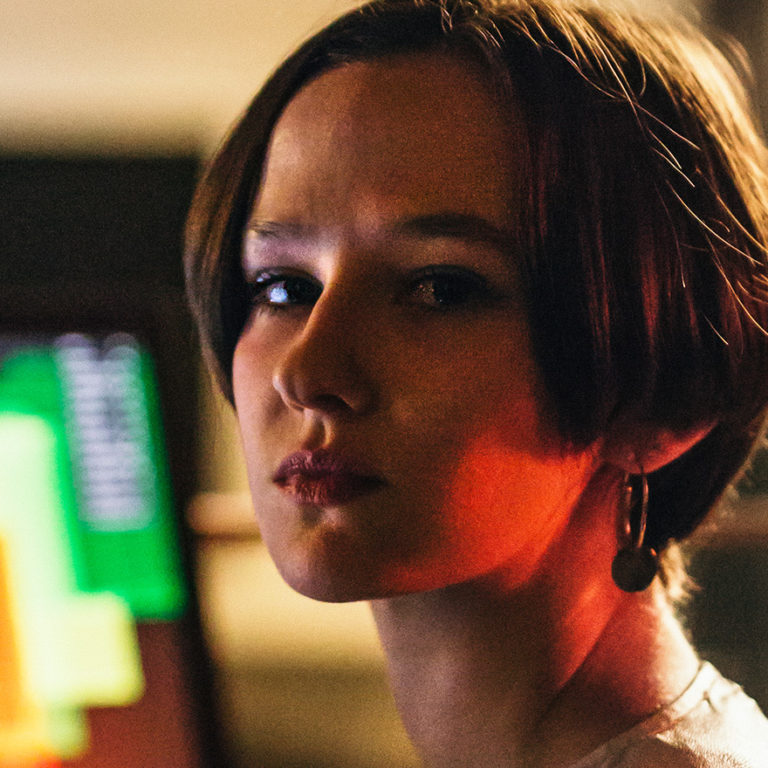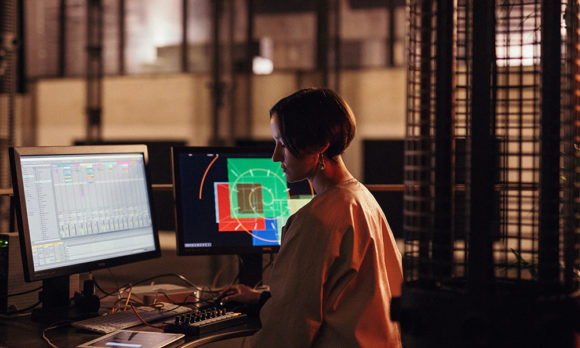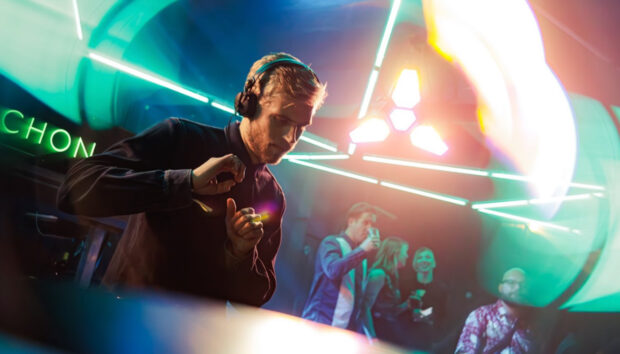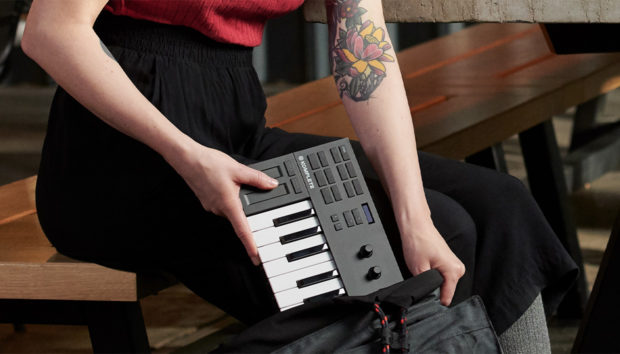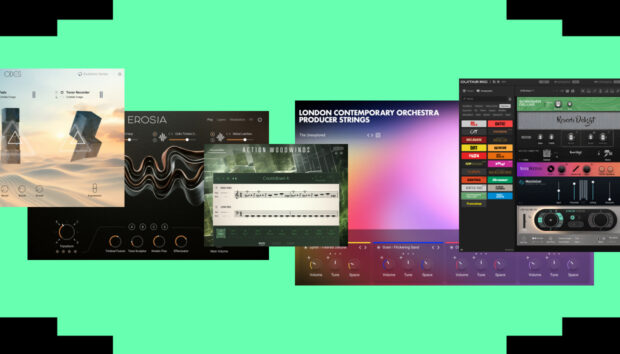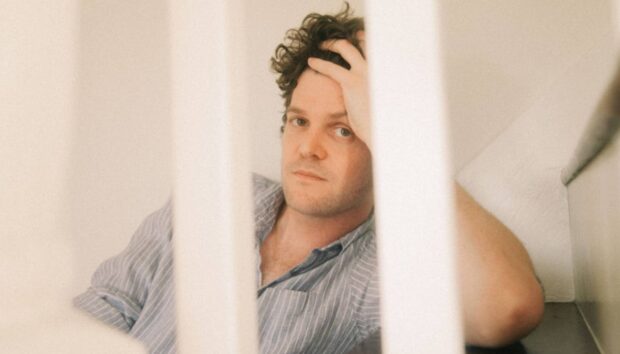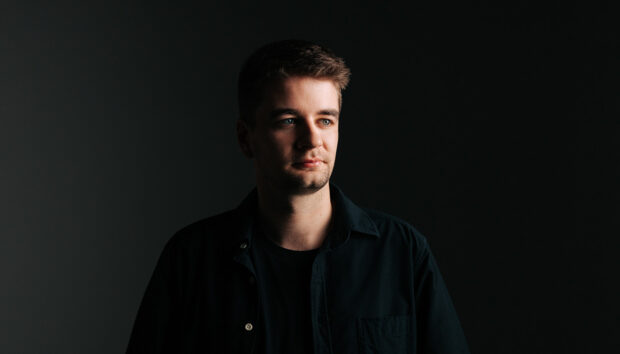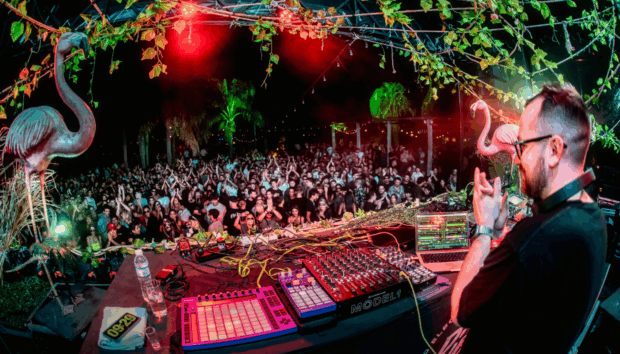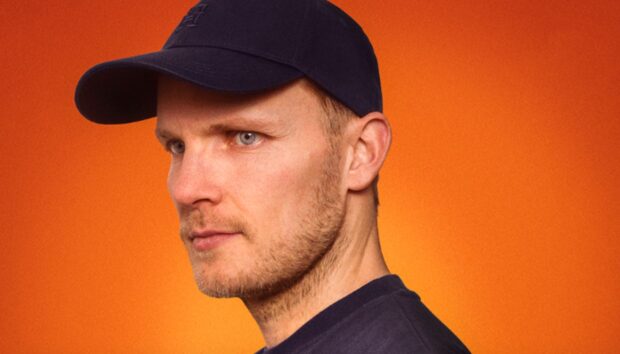Italian minimalist composer Caterina Barbieri talks about the underlying concepts of time and space in her work, specifically in regards to the development of her recent show at MONOM in Berlin. Writing on behalf of Native Instruments, 4DSOUND’s John Connell spoke to Barbieri about the creative possibilities of RAZOR as a tool for sculpting mathematically precise sound design and live performance.
Operating as a collective, the team behind 4DSOUND are exploring spatial sound as a medium. Since its launch in 2007, it has continued to develop an integrated hardware and software system that provides a fully omnidirectional sound environment. In 2015, 4DSOUND founded the Spatial Sound Institute in Budapest, a permanent facility dedicated to the research and development of spatial sound. Last year, experimental performance venue and spatial sound studio MONOM, located at the historic Funkhaus, opened in Berlin with a 4DSOUND system, and has featured bespoke performances from Max Cooper, Gaika, Barbieri, as well as other experimental artists. Sharing her experiences about the lead up to, and actual performance, Barbieri talks about tailoring music for a spatial composition.
Your work explores spatial concepts at an integral level. Did you have a particular concept in mind for your performance working with 4DSOUND at MONOM?
Yes I’ve always been interested in the exploration of space through the use of sound and fascinated by how music can expand and enhance the perception of space. When I was studying electronic music at University, for example, I was very into spatialisation techniques and I did a research project called “Spherical Sound” where I was studying how sound spatialisation techniques, and especially three-dimensional, immersive and extended listening conditions, can develop our listening capabilities and music appreciation. So when I had the opportunity to work with 4DSOUND, my idea was to further investigate these concepts and especially explore how sound spatialisation together with the heavy use of repetition and synthesis can advance our auditory and cognitive comprehension of music.
I wanted to develop a composition focused on the use of recursive musical structures and synthetic audio sources, where space could be explored as the primary compositional parameter, a tool for aural and mental training. I asked myself: can space become the primary origin of music? Can space itself produce time and therefore music? And I was quite surprised to realise how space can be, on its own, the primary originator of musical structures, both in terms of rhythm and pitch.
For example, a completely static sound, like a justly tuned sawtooth chord, if rhythmically sent into random positions in space will generate a musical structure on its own, not only for the rhythmical patterns generated by the random allocations, but also for the variation in the harmonic content produced by the filtering and phase effects induced by the cinematic trajectories. An entire part of my piece with 4DSOUND was all about this. Basically the spatialisation was producing the musical structures on its own – all these melodic and rhythmical patterns hidden in the harmonic content of a ‘static’ sound. And I was quite surprised to realise how the space itself was producing these cubist, layered, complex sonic entities out of a single sound.
It’s like turning the environment itself into an instrument, rather than performing a pre-constructed musical form into what is an essentially passive space. Which is basically how most music is created at the moment.
Yes. This brought me to reflect more in general on the role played by space in the development of music and musical thought back in the days. Think about how the reverberant acoustics of churches and their architecture have played a fundamental role in the first development of polyphonic music! Or how Kraftwerk in Berlin and other abandoned industrial places have shaped the sound of certain aesthetics. Or how the simple phenomenon of the echo between mountains can be considered the most simple manifestation of a music event.

Yes! This is really fascinating. Since 2016 Paul [Oomen, 4DSOUND Founder] has been working on related research at the Spatial Sound Institute in Budapest with Professor Slobodan Dan Paich, a cultural anthropologist who is active in developing the field of archeo-acoustics. It looks at the intentional acoustic design of ancient sacred spaces and the musical practices that developed within them, and to recreate the experience of how they would sound and feel using 4DSOUND’s technology. It gives some insight on how early culture used acoustics to explore our relationship with the environment, and how musical forms emerged out of this process.
I wanted to talk a little about how you approached developing the performance. I often find artists working with the system come with very elaborate ideas to exploit the system’s potential with many voices/sources and a lot of intense spatial movement and dynamics. After a few days, they often change approach entirely, and begin working with individual voices and movements in a more reflective way. For me, this is when the real potential of spatial composition begins to open up. It inevitably invites a minimalism in approach and output, and as a listener I get so much more when there is a lot of negative space within a performance. I can hear the specifics of an individual sound, its characteristics, how it behaves as it moves around you, its relation to other elements of the composition… and ultimately a more direct impression of how the whole space evolves, and the impact it has on my senses. Would you agree? What was your experience?
Yes I totally agree. The more I worked with the system, the more I realized that digging into a single spatial concept was the key to really unfold the potential of the system. So I tried to work in a minimalist way, refining simple but strong spatial concepts. For example, the idea of creating an ever-changing cubist space out of a single sawtooth chord rhythmically sent into random locations. Or the exploration of verticality, by the use of ascending and descending spirals. Or the sculptural definition of harmonic space, by the use of rotation in order to produce filtering and phasing effects. Geometry is a big inspiration on my work so I tried to work with sharp, geometric trajectories. I think that space can be a powerful medium to enhance the perception of sound as a physical object and activate a very attentive, advanced listening attitude towards the ‘microscopic’ properties of sound.
If you can cultivate this level of awareness, you can delve into very minimal content in a way that is deeply meditative as a listener, even if the material itself is intense and visceral.
Let’s talk about your setup. You predominantly work with modular synthesis, like the Buchla 200, which you used on Vertical. What prompted your decision to work with Razor for this residency and show? Was there something specific you wanted to explore with it?
Yes, I decided to work with Razor because I wanted to have super fine control of the harmonic texture of the sound and be able to sculpt it in microscopic detail. I love working with additive synthesis both in the analog and the digital environment, but Razor allows for a ‘clinical’ approach to sound that I find pretty unique, a sort of mathematical, high-resolution precision that wouldn’t be possible with my analog setup. I think that the ‘fine-tuning’ capabilities of this synthesiser open up interesting territories when it comes to the exploration of subtle psychoacoustic phenomena and ‘molecular’ modeling of sound.
I usually approach Razor as I approach modulars, in a quite minimalist way: I start from a simple waveform and then work a lot with additive synthesis to create more complex sounds and processes. For the piece with 4DSOUND I was especially inspired by interference patterns and the acoustic hallucinations produced by fast alternation of sound and silence and was interested in using Razor to explore these concepts.
That makes sense when I think back to your performance. It had a strongly synaesthesic effect I want to try and describe. The sound was very bright with clearly defined edges, but somehow fluid, constantly changing form and intensity, like it was flashing in and out of the space. Standing with my eyes closed, I had the image of something, almost like a living presence, arcing and circling above my head. I had this recurring mental image of a flashing bio-luminescence as it passed over and through me, a deep phosphorous blue. It was very cool, and psychedelic in the truest sense. Does that description resonate with your intention with the sound design and spatial narrative?
Yes definitely. I am happy to hear that because your description of the experience really resonates with my personal intention and perception of the piece! The phosphorescent bio-luminescence beautifully describes the synaesthetic experience I wanted to trigger through the sounds – but instead of a blue, the color I had in mind for this piece was a deep sidereal lush impossible green! Maybe I was also inspired by the light design of the venue at MONOM, I felt that the flickering visual stimuli of the green LEDs there kinda reinforced the sonic personality of the piece while I was developing it, taking it in a specific direction.
I had this idea of using Razor to create alien-artificial-cold sonic entities but at the same time full of a sort of organic life and timeless, archaic, simple beauty. I was also intrigued by the idea of using Razor to resemble the timbre of more traditional, folk instruments like “scacciapensieri” (mouth harp), or bagpipe and this path lead to interesting, unexpected results.
Like RAZOR, the 4DSOUND system has a very wide range of parameters to control spatial dimension and dynamics. It can be used as a spatialisation tool, but also more interestingly as an instrument in itself- modulating object paths, expanding and collapsing object dimensions, triggering spatial delays and a range of other attributes. It’s totally possible to improvise a live performance into something totally unrecognisable from the source material only working with the system itself. How deeply did you integrate 4D tools into the creative process, and at what point in the residency?
Yes that’s true. In the very beginning of my residency for example I applied spatial trajectories on pre-composed material and this approach was very frustrating because the result was never corresponding to what I had in mind.
After a while, I realised that it was more interesting to approach 4DSOUND as a creative instrument and the spatial tools offered by the system as triggers for the compositional design. I especially enjoyed the possibility to work with spatialisation in a highly “quantised”, clock-based environment as Razor and Ableton. This feature allows to define with mathematical precision the time architecture/grid of the spatialisation. And this turns out into a sort of space-ification of time, where time becomes space.
I like this sort of approach because in this way the time structure of the music piece is derived from the space. And this was the main inspiration on the work I did with 4DSOUND I think. As I mentioned before, I derived most of the rhythmic patterns out of a static sound just through layered synced random locations, using the ‘Shake’ and ‘Spasm’ tools in the 4D interface. Another interesting aspect of working in this highly “quantized” spatial environment, is that you can associate a certain spatial trajectory with a certain sound behaviour (i.e cutoff of a filter) on a very integral level of the music composition and time/space architecture of the piece. So you end up creating these fractal structures, where different modulations of the sound are linked to different spatial parameters to create these very organic, complex sonic entities.
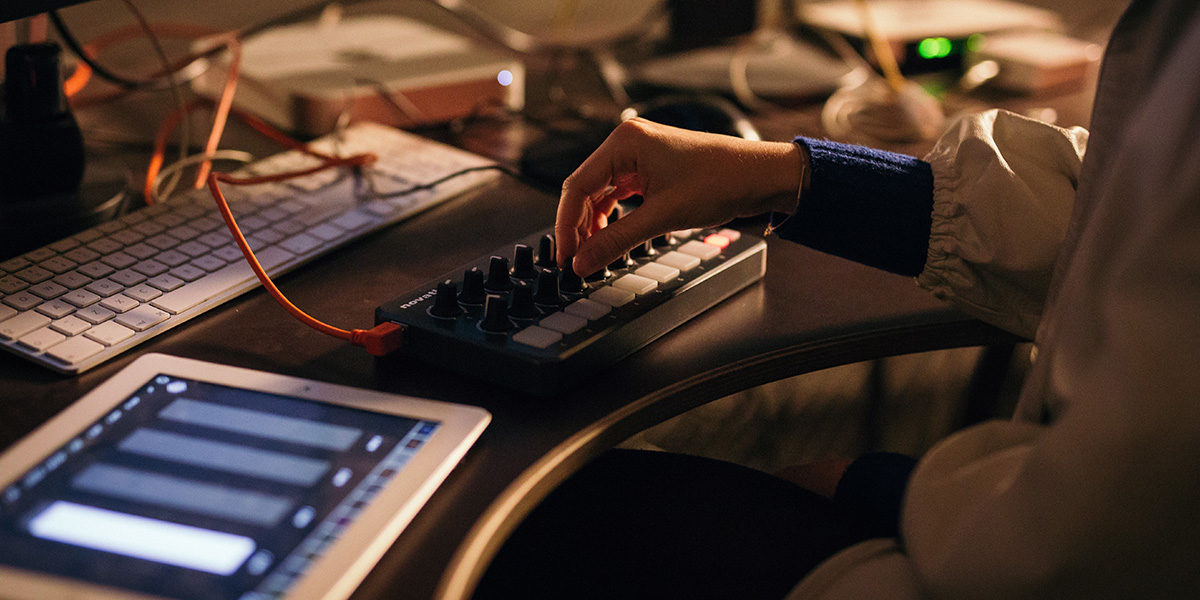
Which created the sense of liquid flux and perpetual motion in your performance. So where will you take these developments next? Are you working with Razor on any upcoming projects?
In my live performances I mostly work with analog stuff but I am slowly integrating pieces all based on Razor. For example in November I premiered a piece for choir, Razor and modulars. The piece I’ve composed for the choir for example is all based on the fast superimposition of chords that differ from each other only in the content of their harmonics, creating these subtle illusory melodic and rhythmic moirè patterns, sort of harmonic ghosts that are made explicit and ‘real’ by the vocal lines of the singers. This piece is called Fantas, an abbreviation for the Ittalian word Fantasma, that means ghost but also contains the etymology of the word phantasy. I was interested in exploring perceptual artefacts through the use of sound and Razor felt like the best instrument to do it for its sharp audio synthesis and its powerful control capabilities.
photo credits: Becca Crawford
provided courtesy of MONOM








